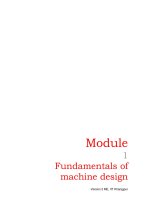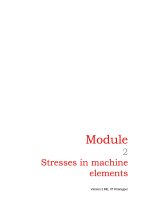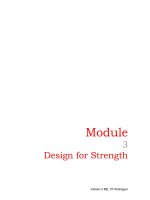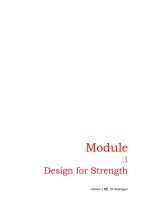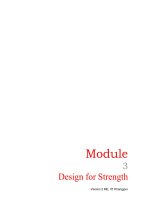Tài liệu Fundamentals of Machine Design P16 ppt
Bạn đang xem bản rút gọn của tài liệu. Xem và tải ngay bản đầy đủ của tài liệu tại đây (307.56 KB, 15 trang )
Module
5
Couplings
Version 2 ME, IIT Kharagpur
Lesson
2
Design procedures for
rigid and flexible
rubber-bushed
couplings
Version 2 ME, IIT Kharagpur
Instructional Objectives
At the end of this lesson, the students should have the knowledge of
• Detailed design procedure of a typical rigid flange coupling.
• Detailed design procedure of a typical flexible rubber-bush coupling.
5.2.1 Rigid Flange Coupling
A typical rigid flange coupling is shown in Figure- 5.1.2.1.4.2.
If essentially consists of two cast iron flanges which are keyed to the shafts
to be joined. The flanges are brought together and are bolted in the annular
space between the hub and the protecting flange. The protective flange is
provided to guard the projecting bolt heads and nuts. The bolts are placed
equi-spaced on a bolt circle diameter and the number of bolt depends on
the shaft diameter d. A spigot ‘A’ on one flange and a recess on the
opposing face is provided for ease of assembly.
The design procedure is generally based on determining the shaft
diameter d for a given torque transmission and then following empirical
relations different dimensions of the coupling are obtained. Check for
different failure modes can then be carried out. Design procedure is given in
the following steps:
(1) Shaft diameter‘d’ based on torque transmission is given by
d =
1/ 3
s
16T
⎛⎞
⎜⎟
πτ
⎝⎠
where T is the torque and τ
y
is the yield stress in shear.
(2) Hub diameter d
1
=1.75d +6.5mm
(3) Hub length L = 1.5d
Version 2 ME, IIT Kharagpur
But the hub length also depends on the length of the key. Therefore this
length L must be checked while finding the key dimension based on shear
and crushing failure modes.
(4) Key dimensions:
If a square key of sides b is used then b is commonly taken as
d
4
. In that
case, for shear failure we have
k
d
.L
4
⎛⎞
⎜⎟
⎝⎠
.τ
y.
d
2
= T where τ
y
is the yield stress in shear and L
k
is the key
length.
This gives L
k
=
2
y
8T
d τ
If L
k
determined here is less than hub length L we may assume the key
length to be the same as hub length.
For crushing failure we have
k
d
.L
8
⎛⎞
⎜⎟
⎝⎠
σ
c
.
d
2
= T where σ
c
is crushing stress induced in the key. This gives
σ
c
=
2
k
16T
Ld
and if σ
c
< σ
cy
, the bearing strength of the key material , the key dimensions
chosen are in order.
(5) Bolt dimensions :
The bolts are subjected to shear and bearing stresses while transmitting
torque.
Considering the shear failure mode we have
2
c
byb
d
n. d T
42
π
τ=
where n is the number of bolts, d
b
the nominal bolt diameter, T is the torque
transmitted, is the shear yield strength of the bolt material and d
yb
τ
c
is the
bolt circle diameter. The bolt diameter may now be obtained if n is known.
The number of bolts n is often given by the following empirical relation:
Version 2 ME, IIT Kharagpur
n =
4
d3
150
+
where d is the shaft diameter in mm. The bolt circle diameter must be such
that it should provide clearance for socket wrench to be used for the bolts.
The empirical relation takes care of this
Considering crushing failure we have
c
b2 cyb
d
n.d t T
2
σ=
where t
2
is the flange width over which the bolts make contact and σ
cyb
is
the yield crushing strength of the bolt material. This gives t
2
. Clearly the bolt
length must be more than 2t
2
and a suitable standard length for the bolt
diameter may be chosen from hand book.
(6) A protecting flange is provided as a guard for bolt heads and nuts. The
thickness t
3
is less than
2
t2. The corners of the flanges should be rounded.
(7) The spigot depth is usually taken between 2-3mm.
(8) Another check for the shear failure of the hub is to be carried out. For this
failure mode we may write
1
12 yf
d
dt T
2
πτ =
where d
1
is the hub diameter and τ
yf
is the shear yield strength of the flange
material.
Knowing τ
yf
we may check if the chosen value of t
2
is satisfactory or not.
Finally, knowing hub diameter d
1
, bolt diameter and protective thickness t
2
we may decide the overall diameter d
3
.
5.2.2 Flexible rubber – bushed couplings
This is simplest type of flexible coupling and a typical coupling of this type
is shown in Figure-5.2.2.1.
Version 2 ME, IIT Kharagpur
t
2
c
t
3
d
neck
d
r
d
br
d
d
1
d
c
Hub
Shaft
Key
Brass bush
Pin
Rubber bush
5.2.2.1F- A typical flexible coupling with rubber bushings.
In a rigid coupling the torque is transmitted from one half of the coupling to
the other through the bolts and in this arrangement shafts need be aligned
very well.
However in the bushed coupling the rubber bushings over the pins (bolts) (as
shown in Figure-5.2.2.1) provide flexibility and these coupling can
accommodate some misalignment.
Because of the rubber bushing the design for pins should be considered
carefully.
(1) Bearing stress
Rubber bushings are available for different inside and out side diameters.
However rubber bushes are mostly available in thickness between 6 mm
to 7.5mm for bores upto 25mm and 9mm thickness for larger bores. Brass
sleeves are made to suit the requirements. However, brass sleeve
Version 2 ME, IIT Kharagpur
thickness may be taken to be 1.5mm. The outside diameter of rubber
bushing d
r
is given by
d
r
= d
b
+2 t
br
+2 t
r
where d
b
is the diameter of the bolt or pin , t
br
is the thickness of the brass
sleeve and t
r
is the thickness of rubber bushing. We may now write
c
r2 b
d
n.d t p T
2
=
where d
c
is the bolt circle diameter and t
2
the flange thickness over the
bush contact area. A suitable bearing pressure for rubber is 0.035 N/mm
2
and the number of pin is given by
d
n
25
3
=
+
where d is in mm.
The d
c
here is different from what we had for rigid flange bearings. This
must be judged considering the hub diameters, out side diameter of
the bush and a suitable clearance. A rough drawing is often useful in this
regard.
From the above torque equation we may obtain bearing pressure
developed and compare this with the bearing pressure of rubber for safely.
(2) Shear stress
The pins in the coupling are subjected to shear and it is a good practice to
ensure that the shear plane avoids the threaded portion of the bolt. Unlike
the rigid coupling the shear stress due to torque transmission is given in
terms of the tangential force F at the outside diameter of the rubber bush.
Shear stress at the neck area is given by
τ
b
=
neck
b
2r
2
ptd
d
4
π
where d
neck
is bolt diameter at the neck i.e at the shear plane.
Bending Stress
The pin loading is shown in Figure-5.2.2.2.
Version 2 ME, IIT Kharagpur
t
2
c
p
d
br
5.2.2.2F- Loading on a pin supporting the bushings.
Clearly the bearing pressure that acts as distributed load on rubber bush
would produce bending of the pin. Considering an equivalent concentrated
load F= pt
2
d the bending stress is
()
br
2
b
3
32F t 2
d
σ=
π
Knowing the shear and bending stresses we may check the pin diameter for
principal stresses using appropriate theories of failure.
We may also assume the following empirical relations:
Hub diameter = 2d
Hub length = 1.5d
Pin diameter at the neck =
0.5d
n
5.2.3 Problems with answers
Q.1: Design a typical rigid flange coupling for connecting a motor and a
centrifugal pump shafts. The coupling needs to transmit 15 KW at
1000 rpm. The allowable shear stresses of the shaft, key and bolt
materials are 60 MPa,50 MPa and 25 MPa respectively. The shear
modulus of the shaft material may be taken as 84GPa. The angle of
Version 2 ME, IIT Kharagpur
twist of the shaft should be limited to 1 degree in 20 times the shaft
diameter.
A.1:
The shaft diameter based on strength may be given by
d =
3
y
16T
πτ
where T is the torque transmitted and τ
y
is the
allowable yield stress in shear.
Here T = Power/
2N
60
π
⎛⎞
⎜⎟
⎝⎠
=
3
15x10
143Nm
2 x1000
60
=
π
⎛⎞
⎜⎟
⎝⎠
And substituting τ
y
= 60x10
6
Pa we have
d =
1
3
2
6
16x143
2.29x10 m 23mm
x60x10
−
⎛⎞
=
⎜⎟
π
⎝⎠
.
Let us consider a shaft of 25 mm which is a standard size.
From the rigidity point of view
TG
JL
θ
=
Substituting T = 143Nm , J =
494
(0.025) 38.3x10 m ,G 84x10 Pa
32
− 9
π
==
99
143
L 38.3x10 x84x10
−
θ
=
= 0.044 radian per meter.
The limiting twist is 1 degree in 20 times the shaft diameter
which is
180
0.035
20x0.025
π
= radian per meter
Therefore, the shaft diameter of 25mm is safe.
We now consider a typical rigid flange coupling as shown in Figure
5.1.2.1.4.2F.
Hub-
Using empirical relations
Hub diameter d
1
= 1.75d + 6.5 mm. This gives
Version 2 ME, IIT Kharagpur
d
1
= 1.75x25 + 6.5 = 50.25mm say d
1
= 51 mm
Hub length L=1.5d. This gives L = 1.5x25 = 37.5mm, say L= 38mm.
Hub thickness t
1
=
1
dd
51 25
13mm
22
−
−
==
Key –
Now to avoid the shear failure of the key (refer to Figure 5.1.2.1.1.2 F)
ky
dd
L T
42
⎛⎞
τ
=
⎜⎟
⎝⎠
where the key width w =
d
4
and the key length is L
k
This gives L
k
=
2
y
8T
(d)τ
i.e.
62
8x143
0.0366 m 36.6 mm
50x10 x(0.025)
==
The hub length is 37.5 mm. Therefore we take L
k
= 37.5mm.
To avoid crushing failure of the key (Ref to Figure 5.1.2.1.1.2 F)
(
k
d
L
8
)σ.
2
d
= T where σ is the crushing stress developed in the key.
This gives
2
k
Ld
16Τ
σ=
Substituting T = 143Nm, L
k
= 37.5 x 10
-3
m and d = 0.025 m
6
32
16x143x10
97.62MPa
37.5x10 x(0.025)
−
−
σ= =
Assuming an allowable crushing stress for the key material to be
100MPa, the key design is safe. Therefore the key size may be taken
as: a square key of 6.25 mm size and 37.5 mm long. However keeping
in mind that for a shaft of diameter between 22mm and 30 mm a
rectangular key of 8mm width, 7mm depth and length between 18mm
and 90mm is recommended. We choose a standard key of 8mm width,
7mm depth and 38mm length which is safe for the present purpose.
Bolts.
To avoid shear failure of bolts
2
c
byb
d
nd T
42
π
τ=
where number of bolts n is given by the empirical relation
Version 2 ME, IIT Kharagpur
4
nd
150
=+
3
where d is the shaft diameter in mm.
which gives n=3.66 and we may take n=4 or more.
Here τ
yb
is the allowable shear stress of the bolt and this is assumed to
be 60 MPa.
d
c
is the bolt circle diameter and this may be assumed initially based
on hub diameter d
1
=51 mm and later the dimension must be justified
Let d
c
=65mm.
Substituting the values we have the bolt diameter d
b
as
d
b
=
1
2
yb c
8T
nd
⎛⎞
⎜⎟
⎜⎟
πτ
⎝⎠
i.e.
1
2
3
63
8x143
7.48x10
4x25x10x65x10
−
−
⎛⎞
=
⎜⎟
π
⎝⎠
which gives d
b
= 7.48 mm.
With higher factor of safety we may take d
b
= 10 mm which is a
standard size.
We may now check for crushing failure as
c
b2 c
d
nd t T
2
σ=
Substituting n=4, d
b
=10mm,σ
c
=100MPa,d
c
=65mm&T=143Nm and this
gives t
2
=2.2mm.
However empirically we have t
2
=
1
1
t6.513mm
2
+=
Therefore we take t
2
=13mm which gives higher factor of safety.
Protecting flange thickness.
Protecting flange thickness t
3
is usually less than
2
1
2
t
we therefore
take t
3
= 8mm since there is no direct load on this part.
Version 2 ME, IIT Kharagpur
Spigot depth
Spigot depth which is mainly provided for location may be taken as
2mm.
Check for the shear failure of the hub
To avoid shear failure of hub we have
1
12 f
d
dt T
2
πτ =
Substituting d
1
=51mm, t
2
=13mm and T = 143Nm, we have shear
stress in flange
f
τ
as
f
τ
=
1
2
2
2T
(d t)π
And this gives = 2.69 MPa which is much less than the yield shear
value of flange material 60MPa.
f
τ
Q.2: Determine the suitable dimensions of a rubber bush for a flexible
coupling to connect of a motor and a pump. The motor is of 50 KW and
runs at 300rpm. The shaft diameter is 50mm and the pins are on pitch
circle diameter of 140mm. The bearing pressure on the bushes may be
taken as 0.5MPa and the allowable shear and bearing stress of the pin
materials are 25 MPa and 50 MPa respectively. The allowable shear
yield strength of the shaft material may be taken as 60MPa.
A.2:
A typical pin in a bushed flexible coupling is as shown in Figure-5.2.3.1.
Version 2 ME, IIT Kharagpur
L
L
1
d
neck
Enlarged
Diameter
Rubber bush
Brass sleeve
5.2.3.1F- A typical pin for the bushings.
There is an enlarged portion on which a flexible bush is fitted to absorb
the misalignment. The threaded portion provided for a nut to tighten on
the flange. Considering the whole pin there are three basic stresses
developed in the pin in addition to the tightening stresses. There are (a)
shear stresses at the unthreaded neck area (b) bending stress over the
loaded portion (L) of the enlarged portion of the pin and (c) bearing
stress.
However, before we consider the stresses we need to determine the pin
diameter and length. Here the torque transmitted
3
50x10
T 159Nm
2 x3000
60
==
π
⎛⎞
⎜⎟
⎝⎠
Based on torsional shear the shaft diameter
1
3
y
16T
d
⎛⎞
=
⎜⎟
⎜⎟
πτ
⎝⎠
Substituting T=159Nm and τ
y
= 60MPa, we have d = 23.8mm. Let the
shaft diameter be 25mm. From empirical relations we have
Pin diameter at the neck d
neck
=
0.5d
n
where the number of pins n =
4d
3
150
+
Version 2 ME, IIT Kharagpur
Substituting d = 25 mm we have
n = 3.67 (say) 4
d
neck
= 6.25 (say) 8mm
On this basis the shear stress at the neck =
2
neck
c
T
d
dn
42
π
⎡
⎤
⎢
⎥
⎣
⎦
which gives
11.29 MPa and this is much less than yield stress of the pin material.
There is no specific recommendation for the enlarged diameter based on
d
neck
but the enlarged diameters should be enough to provide a neck for
tightening. We may choose
d
enlarged
= 16mm which is a standard size. Therefore we may determine
the inner diameter of the rubber bush as
d
bush
= Enlarged diameter of the pin + 2x brass sleeve thickness.
A brass sleeve of 2mm thickness is sufficient and we have
d
bush
= 20mm
Rubber bush of core diameter up to 25mm are available in thickness of
6mm. Therefore we choose a bush of core diameter 20mm and
thickness 6mm.
In order to determine the bush length we have
c
bush
d
T npLd
2
=
where p is the bearing pressure, (Ld
bush
) is the projected area and d
c
is
the pitch circle diameter. Substituting T= 159Nm, p = 0.5MPa, d
bush
=
0.02m and d
c
= 0.14m we have L = 56.78 mm.
The rubber bush chosen is therefore of 20mm bore size, 6mm wall
thickness and 60 mm long.
5.2.4 Summary of this Lesson
Detailed design procedure of a rigid flange coupling has been discussed in
which failure modes of different parts such as the shaft, key, bolts and
protecting flange are described. Design details of a flexible coupling using
Version 2 ME, IIT Kharagpur
rubber bushings have also been discussed. Here the failure modes of the
flexible rubber bushings have been specially considered. Some typical
problems have also been solved.
5.2.5 Reference for Module-5
1) A textbook of machine design by P.C.Sharma and D.K.Agarwal,
S.K.Kataria and sons, 1998.
2) The elements of machine design by S.J.Berard and E.O.Waters, D.Van
Nostrand Company, 1927.
3) Design of machine elements by M.F.Spotts, Prentice hall of India, 1991.
4) Mechanical engineering design by Joseph E. Shigley, McGraw Hill,
1986.
5) A text book of machine drawing by R. K. Dhawan, S. Chand and Co.
Ltd., 1996.
Version 2 ME, IIT Kharagpur


